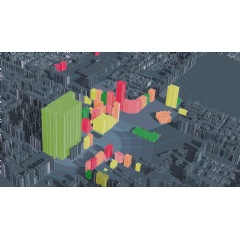New tool to assess combustible facade fire risks in high-rise buildings
The National Fire Protection Association (NFPA) has sponsored research by Arup, resulting in the creation of EFFECT™, an Exterior Facade Fire Evaluation Comparison Tool to help global building owners, facility managers and authorities having jurisdiction (AHJs) proactively assess risk in their high-rise building inventory with combustible facades. Enforcement authorities and those responsible for managing large portfolios of high rise buildings have been lacking a tool to assess and prioritize remediation works.
Fires in high-rise buildings with combustible exterior wall assemblies have occurred in cities from Berlin to Las Vegas to Dubai to London. In response to concern around the world, NFPA sponsored research by Arup, a global firm of engineering consultants, designers and planners working across every aspect of today’s built environment, to develop a risk assessment methodology that enables the prioritization of mitigation work. The Fire Protection Research Foundation facilitated a detailed review of the project with input from an international panel including Jensen Hughes as peer reviewers and Thomas Bell Wright of Dubai as advisors on facade systems fire testing. This High-
Rise Buildings with Combustible Exterior Wall Assemblies research takes into account the building envelope; potential ignition sources; building characteristics; and existing fire safety measures such as means of warning, containment, and extinguishment. The result is the comprehensive prioritization tool, EFFECT.
“High-rise fires, where combustible facades are present, tend to move swiftly and can cause tremendous loss of life and property,” NFPA Director of Applied Research Birgitte Messerschmidt said. “We have seen news footage of fully engulfed high-rise buildings; and heard from concerned stakeholders looking to get out in front of facade fire and life safety problems. Arup’s thorough research allowed us to create EFFECT so that authorities can now prioritize inspection and remediation efforts in their jurisdiction.”
“Keeping communities safe is at the heart of our work and it has become increasingly clear that there is a significant need to help building owners and authorities to risk-assess buildings with combustible facade systems in their portfolios and where necessary, prioritize remediation work” Susan Lamont Arup Fire Engineering Leader
EFFECT takes into account the building, the facade, and the impact of potential ignition sources such as fire spreading from inside the building, or fire stemming from a vehicle, trash container, or balcony outside. The tool employs a two-tiered risk assessment process:
-
Tier 1 entails an AHJ, building owner, or facility manager answering a small number of questions with clearly pre-defined answers, to inform the ranking of buildings within their portfolio. Some questions pertain to the combustibility of the insulation and facade cladding; the presence of sprinklers; potential ignition sources; and the type of alarm system.
-
Tier 2 is where authorities will complete a deeper fire risk assessment evaluation of those buildings deemed at risk in Tier 1. Onsite inspection; as-built information; maintenance records; samplings; and laboratory testing of unknown facade materials are considered in this section.
EFFECT, which is free to access, comes with a user’s guide that describes the methodology but is intended to help the user to answer each of the questions posed by EFFECT through words, images and examples.
In some instances, EFFECT will highlight the need for a more detailed risk assessment by a qualified team of facade and fire engineers. The tool can be used in any geographic area; and currently applies to residential (hotel, apartments) or business (office) type occupancies that are over 18m high. This height is measured as the vertical distance from the fire department access level to the uppermost occupied floor of the building. EFFECT assesses risk in existing buildings and has not been created for use in new building design.
( Press Release Image: https://photos.webwire.com/prmedia/7/220396/220396-1.jpg )
WebWireID220396
This news content was configured by WebWire editorial staff. Linking is permitted.
News Release Distribution and Press Release Distribution Services Provided by WebWire.
